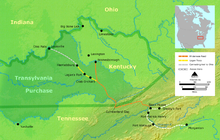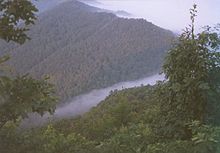Cumberland Gap
- "Cumberland Gap" is also the informal name for a section of the A74 in England; the name of a song by skiffle artist Lonnie Donegan; and the name of an old-time fiddle tune with many variants.
| Cumberland Gap |
|---|

Cumberland Gap (el. 1600 ft./488 m.) is a pass through the Cumberland Mountains region of the Appalachian Mountains, also known as the Cumberland Water Gap. Famous in American history for its role as the chief passageway through the central Appalachians, it was an important part of the Wilderness Road. Long used by Native Americans, the path was widened by a team of loggers led by Daniel Boone, making it accessible to pioneers, who used it to journey into the western frontiers of Kentucky and Tennessee.
Location
Cumberland Gap is located just north of the spot where the current-day states of Kentucky, Tennessee, and Virginia meet. The nearby town of Cumberland Gap, Tennessee takes its name from the pass.
The gap was formed by an ancient creek, flowing southward, which cut through the land being pushed up to form the mountains. As the land rose even more, the creek reversed direction flowing into the Cumberland River to the north. The gap was used by Native Americans and migrating animal herds.
History
The gap was named for Prince William Augustus, Duke of Cumberland, who had many places named for him in the American colonies after the Battle of Culloden. The explorer Thomas Walker gave the name to the Cumberland River in 1750, and the name soon spread to many other features in the region, such as the Cumberland Gap.
In 1775, Daniel Boone, hired by the Transylvania Company led a company of men to widen the path through the gap to make settlement of Kentucky and Tennessee easier. The trail was widened in the 1790s to accommodate wagon traffic.

It is estimated that between 200,000 and 300,000 immigrants passed through the gap on their way into Kentucky and the Ohio Valley before 1810. Today 18,000 cars pass beneath the site daily, and 1,200,000 people visit the park on the site annually.[1]
U.S. Route 25E passed overland through the gap before the completion of the Cumberland Gap Tunnel in 1996. The original trail was then restored.
Geological features

The 12-mile (19 km) long Cumberland Gap consists of four geologic features: the Yellow Creek valley, the natural gap in the Cumberland Mountain ridge, the eroded gap in the Pine Mountain, and Middlesboro crater.
Middlesboro crater is a 3-mile (4.8 km) diameter meteorite impact crater in which Middlesboro, Kentucky is located. The crater was identified in 1966 when Robert Dietz discovered shatter cones in sandstone, which led to the further identification of shocked quartz. Shatter cones, a rock shattering pattern naturally formed only during impact events, are found in abundance in the area. In September 2003 the site was designated a Distinguished Geologic Site by the Kentucky Society of Professional Geologists.[citation needed]
Without Middlesboro crater, it would have been difficult for packhorses to navigate this gap and improbable that wagon roads would have been constructed at an early date. Middlesboro is the only place in the world where coal is mined inside an impact crater. Special mining techniques must be used in the complicated strata of this crater. (Milam & Kuehn, 36).[citation needed]
References in popular culture
- The Gap features in the song "Mighty Joe Moon" on the album of the same name by American band Grant Lee Buffalo.
- Woody Guthrie sings "Cumberland Gap" on his album, "Pastures of Plenty".
- The gap became known in the United Kingdom as the result of a song sung by the skiffle group The Vipers Skiffle Group.
- A style of beard with sideburns that has a "gap" cut through it about an inch wide right below each earlobe is colloquially known by some as a "Cumberland Gap".
- The song "Wagon Wheel" written by Bob Dylan and performed by the band Old Crow Medicine Show mentions the Cumberland Gap.
- The song "Thunder Road" refers to Cumberland Gap in the phrase "Roarin’ out of Harlan, revvin’ up his mill, He shot the gap at Cumberland, and screamed by Maynordsville".

See also
References
External links
Template:Geolinks-US-hoodscale
- Rickie Longfellow, Back in Time: The Cumberland Gap, United States Department of Transportation, Federal Highway Administration
